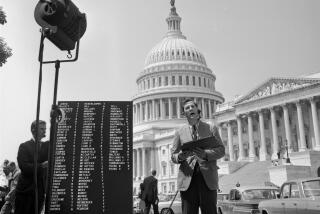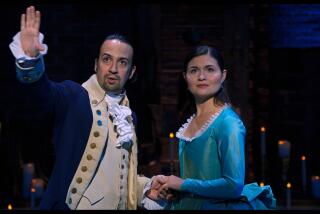250 years after America went to war for independence, a divided nation battles over its legacy

- Share via
LEXINGTON, Mass. — Thousands of people came to this Massachusetts town over the weekend to witness a reenactment of how the American Revolution began 250 years ago, with the blast of gunshot and a trail of colonial spin.
Starting with Saturday’s anniversary of the Battles of Lexington and Concord, the country will look back to its war of independence and ask where its legacy stands today. Just after dawn Saturday on the Lexington Battle Green, militiamen, muskets in hand, took on a much larger army of British regulars. The battle ended with eight Americans dead and 10 wounded — the dead scattered on the grounds as the British marched off.
The regulars would head to Concord, but not before a horseman, Dr. Samuel Prescott, rode toward the North Bridge, warning communities along the way that the British were coming. A lone horseman reenacted that ride Saturday, followed by a parade through town and a ceremony at the bridge.
The day offered an opportunity to reflect on this seminal moment in history but also consider what this fight means today.
“It’s truly momentous,” said Richard Howell, who portrayed Lexington Minuteman Samuel Tidd in the battle.
“This is one of the most sacred pieces of ground in the country, if not the world, because of what it represents,” he said. “To represent what went on that day, how a small town of Lexington was a vortex of so much. ... Lexington was the first town that was able to anywhere muster men and were the first to face the onslaught of the British.”
Among those watching the Lexington reenactment was Brandon Mace, a lieutenant colonel with the Army Reserve who said his fifth great-grandfather Moses Stone was part of the Lexington militia.
He said watching the reenactment was “a little emotional.”
“He made the choice just like I made and my brother made, and my son is in the Army as well,” Mace said. “We weren’t drafted. We weren’t forced to do this. He did not know we would be celebrating him today. He did not know that he was participating in the birth of the nation. He just knew his friends and family were in danger.”
The semiquincentennial comes as President Trump, the scholarly community and others mark a national divide over whether to have a yearlong party leading up to July 4, 2026, as Trump has called for, or to balance any celebrations with questions about women, the enslaved and Indigenous people and what their stories reveal.
The history of Lexington and Concord in Massachusetts is half-known, the myth deeply rooted.
What happened at Lexington and Concord?
Reenactors may with confidence tell us that hundreds of British troops marched from Boston in the early morning of April 19, 1775, and gathered about 14 miles northwest on Lexington’s town green.
Firsthand witnesses remembered that some British officers yelled, “Throw down your arms, ye villains, ye rebels!” and that amid the chaos a shot was heard, followed by “scattered fire” from the British. The battle turned so fierce that the area reeked of burning powder. By day’s end, the fighting had continued around seven miles west to Concord and some 250 British and 95 Colonists were killed or wounded.
But no one has learned who fired first, or why. And the Revolution was initially less a revolution than a demand for better terms.
Woody Holton, a professor of early American history at the University of South Carolina, says most scholars agree the rebels of April 1775 weren’t looking to leave the empire, but to repair their relationship with King George III and go back to the days preceding the Stamp Act, the Tea Act and other disputes of the previous decade.
“The Colonists only wanted to turn back the clock to 1763,” he said.
Stacy Schiff, a Pulitzer Prize-winning historian whose books include biographies of Benjamin Franklin and Samuel Adams, said Lexington and Concord “galvanized opinion precisely as the Massachusetts men hoped it would, though still it would be a long road to a vote for independence, which Adams felt should have been declared on 20 April 1775.”
But at the time, Schiff added, “it did not seem possible that a mother country and her colony had actually come to blows.”
A fight for the ages
The rebels had already believed their cause greater than a disagreement between subjects and rulers. Well before the turning points of 1776, before the Declaration of Independence or Thomas Paine’s exhortation that “we have it in our power to begin the world over again,” they cast themselves in a drama for the ages.
The so-called Suffolk Resolves of 1774, drafted by civic leaders of Suffolk County, Mass., prayed for a life “unfettered by power, unclogged with shackles,” a fight that would determine the “fate of this new world, and of unborn millions.”
The Revolution was an ongoing story of surprise and improvisation. Military historian Rick Atkinson, whose “The Fate of the Day” is the second of a planned trilogy on the war, called Lexington and Concord “a clear win for the home team,” if only because the British hadn’t expected such impassioned resistance from the Colonists’ militia.
The British, ever underestimating those whom King George regarded as a “deluded and unhappy multitude,” would be knocked back again when the rebels promptly framed and transmitted a narrative blaming the royal forces.
“Once shots were fired in Lexington, Samuel Adams and Joseph Warren did all in their power to collect statements from witnesses and to circulate them quickly; it was essential that the Colonies, and the world, understand who had fired first,” Schiff said. “Adams was convinced that the Lexington skirmish would be ‘famed in the history of this country.’ He knocked himself out to make clear who the aggressors had been.”
A country still in progress
Neither side imagined a war lasting eight years, or had confidence in what kind of country would be born out of it. The Founders united in their quest for self-government but differed how to actually govern, and whether self-government could even last.
Americans have never stopped debating the balance of powers, the rules of enfranchisement or how widely to apply the declaration that “all men are created equal.”
That debate was very much on display Saturday — though mostly on the fringes and with anti-Trump protesters far outnumbered by flag-waving tourists, local residents and history buffs. Many protesters carried signs inspired by the American Revolution including “No King Then. No King” and “Resist Like It’s 1775,” and one brought a puppet featuring an orange-faced Trump.
“It’s a very appropriate place and date to make it clear that as Americans we want to take a stand against what we think is an encroaching autocracy,” Glenn Stark, a retired physics professor who was holding a “No Kings” sign and watching the ceremony at the North Bridge. “I feel strongly that it’s time to stand here and make it clear that we aren’t going to sit back and let this happen to our country.”
Democratic Massachusetts Gov. Maura Healey, who spoke at the North Bridge ceremony, also used the event to remind the cheering crowd that many of the ideals fought for during the Revolution are once again at risk.
“We live in a moment when our freedoms are once again under attack, including from the highest office in the land,” she said.
“We see things that would be familiar to our Revolutionary predecessors — the silencing of critics, the disappearing people from our streets, demands for unquestioned fealty,” she said. “Due process is a foundational right. If it can be discarded for one, it can be lost for all.”
Italie and Casey write for the Associated Press.
More to Read
Get the L.A. Times Politics newsletter
Deeply reported insights into legislation, politics and policy from Sacramento, Washington and beyond. In your inbox twice per week.
You may occasionally receive promotional content from the Los Angeles Times.










